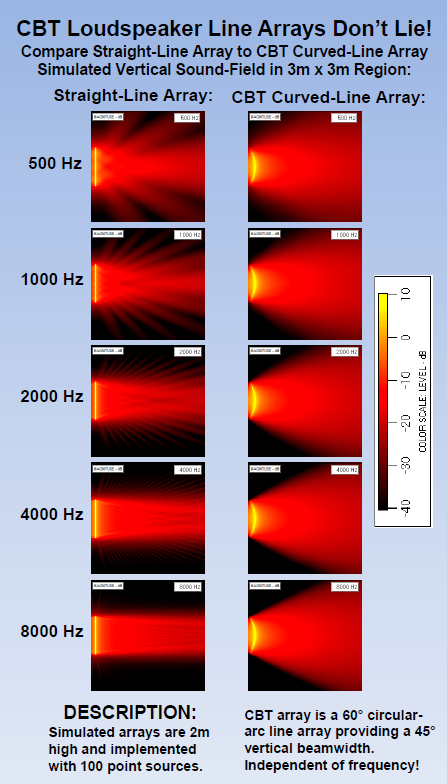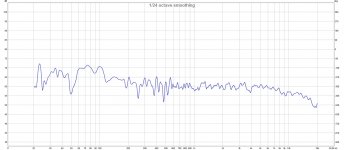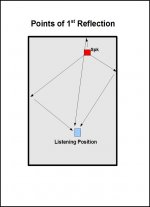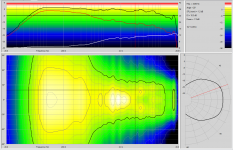You can get the best speaker in the world with tiptop specs etc. But until you look at what it does in a real room what would it be worth? Sure it will differ from room to room. But what I want to know if it's capable of working with a room (as I expect the CBT to be able to do that, just like my straight arrays).
Looking at a CBT as measured in a room at the listening spot is what counts for me. A description of what the room consists of will help.
Thanks for the plot. I'd rather see the IR and STEP, as well as an early waterfall plot, but that's just me... This looks like it's working with this particular room. Seeing the FR + phase curve belonging to this ETC would help too.
I'm not buying a paper from Keele, the previous free ones were too disappointing in content for me to think/believe this one is going to be different.
Looking at a CBT as measured in a room at the listening spot is what counts for me. A description of what the room consists of will help.
Thanks for the plot. I'd rather see the IR and STEP, as well as an early waterfall plot, but that's just me... This looks like it's working with this particular room. Seeing the FR + phase curve belonging to this ETC would help too.
I'm not buying a paper from Keele, the previous free ones were too disappointing in content for me to think/believe this one is going to be different.
Last edited:
Seeburg G16 is a huge speaker for music halls. They have also a smaller fullrange model L-Serie http://www.seeburg.net/download_get...tasheets/L-Series/L-Series_Datasheet_engl.pdf
Notice how horizontal directivity is lost below 1500Hz now but vertical is sharp to 300Hz.
Domestic small rooms make it difficult to realize the benefits of CBT radiation pattern in small scale. Side walls and the ceiling are usually too close. It would be nice to hear a cbt to get real impressions...
Notice how horizontal directivity is lost below 1500Hz now but vertical is sharp to 300Hz.
Domestic small rooms make it difficult to realize the benefits of CBT radiation pattern in small scale. Side walls and the ceiling are usually too close. It would be nice to hear a cbt to get real impressions...
Last edited:
If it didn't work well in a room, it wouldn't measure well either. 😉
The graph was from a 60-65m2 L-shaped room with sloping ceiling. The speakers were placed diagonally in the room; so side wall reflections were minimized. But there were reflections from an angled ceiling. No treatment in ceiling or on side walls. Wooden floor.
Here's a frequency response with the same placement (with non optimum EQ/shelving).
The graph was from a 60-65m2 L-shaped room with sloping ceiling. The speakers were placed diagonally in the room; so side wall reflections were minimized. But there were reflections from an angled ceiling. No treatment in ceiling or on side walls. Wooden floor.
Here's a frequency response with the same placement (with non optimum EQ/shelving).
Attachments
How can you say the ceiling is too close when the CBT avoids ceiling reflections to a large degree (if the ceiling is flat)? The vertical beamwidth of CBT36 is 28 degrees.Domestic small rooms make it difficult to realize the benefits of CBT radiation pattern. Side walls and the ceiling are usually too close. It would be nice to hear a cbt to get real impressions...
If it didn't work well in a room, it wouldn't measure well either. 😉
The graph was from a 60-65m2 L-shaped room with sloping ceiling. The speakers were placed diagonally in the room; so side wall reflections were minimized. But there were reflections from an angled ceiling. No treatment in ceiling or on side walls. Wooden floor.
Here's a frequency response with the same placement (with non optimum EQ/shelving).
Thanks, this helps put together a total picture of that ETC plot. I'd like to ask for more and more, just because I'm curious.
It's also why I try and share everything, because if we all did this we can learn more from each other's experiences. I'll withhold spamming this thread with my own measurements (lol). They are not that hard to find elsewhere.
Read the paper again.
There is no benefit to the CBT over a full floor to ceiling array.
(and ceiling "reflections" are a disadvantage to a CBT, not a benefit.)
If you think there is, then please cite it.
_-_-
Is your array shaded? It also would be interesting to see the response of a floor to ceiling array measured at different distances to observe the interference patterns of the drivers. Have you ever shot a curve with just the top and bottom drivers (or overlayed curves of the two measured individually versus both connected)? Just curious to see how well everything sums.
I would guess that most listeners with a floor to ceiling are not sitting with ear level being at the center of the array. In that case vertical response curves might be informative.
A lot of what you're asking has been measured by ra7 in this thread using raw un-EQ-ed measurements:
http://www.diyaudio.com/forums/multi-way/284371-corner-floor-ceiling-line-array-using-vifa-tc9.html
Not all of your questions, but it does show general trends.
My arrays are not shaded, I still think it would be unwise with floor to ceiling arrays that use the floor and ceiling as reflective surfaces. You could see those reflections as shaded parts of a bigger array though, which is why we use these tall arrays.
Isn't the theoretical centre of the CBT array at floor level? At least that's how that second half of the CBT is shown in Keele's papers.
http://www.diyaudio.com/forums/multi-way/284371-corner-floor-ceiling-line-array-using-vifa-tc9.html
Not all of your questions, but it does show general trends.
My arrays are not shaded, I still think it would be unwise with floor to ceiling arrays that use the floor and ceiling as reflective surfaces. You could see those reflections as shaded parts of a bigger array though, which is why we use these tall arrays.
Isn't the theoretical centre of the CBT array at floor level? At least that's how that second half of the CBT is shown in Keele's papers.
Last edited:

Conventional loudspeakers produce spherical wavefronts
straight line arrays produce cylindrical wavefronts
One dimensional CBT arrays produce curved wavefronts
Two dimensional CBT arrays produce spherical wavefronts
I've listened to CBT arrays and straight arrays on the same day. The subjective difference to me is that the CBT is closer to the 'pinpoint' imaging that you can get with a good conventional loudspeaker. The straight line arrays tend to produce a big stage, but it's diffuse.
A lot of this will be subject to taste. I emailed someone who produced a well documented CBT, and he indicated that he'd opted to go back to straight arrays. Then again, his location is similar to the person that Rick said he's building a CBT for. So it's possible it's the same person and he went back to CBTs!
I think much of the perception of a speaker is visual and listeners can sometimes have a wrong conclusion / expectation before they even start to hear the design. A good example is a few years back when I was standing near a CBT on static display and a speaker designer (of both arrays and point source speakers) made a comment. He noted how ceiling reflections would be a problem - obviously he had no idea how a CBT operates.
We may know the same person in Texas - the CBT builder I mentioned is another DIY guy. If you're referring to the same person I think he only changed back to no shading with his L/R arrays but still has a CBT horizontal center channel.
Last edited:
How can you say the ceiling is too close when the CBT avoids ceiling reflections to a large degree (if the ceiling is flat)? The vertical beamwidth of CBT36 is 28 degrees.
It obviously helps, but response doesn't drop to zero at 29# does it? Ceilings are often built with lowered substructures that suck lots of energy. The route for ceiling reflection is quite long so typically first reflection null from there is below 200Hz. Front-wall, floor and backwall bounces appear stronger and higher than that. https://mehlau.net/audio/floorbounce/
There are other ways to get strong directivity below 1kHz too like dipoles and large horns or tall WWMTMWW speakers. They all have adds and odds and I don't think that there is one generally superior to others.
I think much of the perception of a speaker is visual and listeners can sometimes have a wrong conclusion / expectation before they even start to hear the design. A good example is a few years back when I was standing near a CBT on static display and a speaker designer (of both arrays and point source speakers) made a comment. He noted how ceiling reflections would be a problem - obviously he had no idea how a CBT operates.
We may know the same person in Texas - the CBT builder I mentioned is another DIY guy. If you're referring to the same person I think he only changed back to no shading with his L/R arrays but still has a CBT horizontal center channel.
Yep, same dude 🙂
I have done the direct comparison between CBT36 and Abbey several times and in different rooms as well. First of all, both measure measure very even above 1000 Hz in every room. The difference however, is below 1KHz. Here the Abbey measures like a roller coaster, while the CBT36 is still very flat down to approximately 300-400 Hz. The difference here is due to the fact that the CBT has constant directivity much lower in frequency.
You are implying that horizontal reflections do not affect the sound field since the CBT has many more horizontal reflections, even below 1 kHz, than an Abbey. CBT's may be CD below 1 kHz, but at an extremely low DI, This means that they are more affected by the room than an Abbey, not less. Simply stated, your claim sounds like a Trumpism to me.
Floor and ceiling reflections do have tonal effects, as Earl has noted, and they are pretty hard to treat in normal listening rooms. This is what the CBT and other home line arrays address. Reflections from walls are much easier to treat and control.
But treating the side walls kills the spaciousness, while killing the floor and ceiling do not. One can hardly call these two things equivalent.
This is correct, there is no perfect situation for all genre of music. I have talked about this to great extent. But, if you consider the fact that about 95% of all recorded music today is studio work, not original venue, then it becomes obvious what direction is best for most. High spaciousness helps to mask the inadequacies of two channel for live venue recording, while high directivity (high DI) brings out the imaging aspects of studio work. CBTs have very low DI, while Abbeys have a higher DI - throughout their entire bandwidth!Whether people want side wall reflections or not may be a matter of taste, the room geometry and what music material one is listening to. ... And lateral contribution is basically desired if they are delayed sufficiently.
So with a traditional CBT speaker, the closest side wall reflections would in most rooms be best to treat. While the opposite side wall reflections can be used as a lateral contribution if desired. The spectral content will be very similar to the direct signal.
This is so ridiculous! To kill the near wall for each speaker you have to kill the far wall for the other one. This kills the side wall reflections for all future reflections, thus killing any spaciousness to be derived from the room itself. This is NOT the way to go, although you may, and seem to, prefer it. Most people that I know are the exact opposite. You appear to be unique. Maybe that's what you are seeking, I don't know.
Last edited:
But treating the side walls kills the spaciousness, while killing the floor and ceiling do not. One can hardly call these two things equivalent.
I didn't call them equivalent, just that walls are easier to treat than the floor and ceiling.
I have corner arrays myself, so I don't have the problems of reflections from the near wall. I agree with you Earl that side wall reflections add a nice sense of spaciousness. For a long time I was listening to those first reflections absorbed, and while it improved imaging, it killed the spaciousness. I just prefer the added spaciousness. Many people prefer it the other way around. In his book, Toole also notes that treating side walls or leaving them alone is a matter of preference, depending on the directivity of speakers and how much spaciousness is desired.
With a horn+woofer design, there is no control of directivity below maybe 600-700 Hz, so, there will be reflections in that range from the near wall. Conventional designs can also be pointed inwards or the speakers can be positioned away from the walls. And reflections arriving from the side are not that detrimental anyway. Many ways to skin the cat.
ra7 - all correct.
Toole almost never listens to studio work, its all live venue, and his preferences show this. I believe he came to realize that there is no one solution and so he now believes that "treating side walls or leaving them alone is a matter of preference", however, he does not say who might prefer which, and that studio work is better served by High DI speakers with lively side walls.
I am doing some experiments now that seem to be showing that placement of "image" is dominated by harmonics and signals > 700 Hz. (in agreement with Griesinger.) This would imply that controlling directivity < 700 Hz is not nearly as important as controlling it > 700 Hz. Given a tradeoff, as there always are, the > 700 Hz will win out in every case. Corner placement may be a solution, I don't have that experience, but it is exceptional. I could not do it in my room, its not practical. So I stick with High DI CD speakers that work in any location.
Toole almost never listens to studio work, its all live venue, and his preferences show this. I believe he came to realize that there is no one solution and so he now believes that "treating side walls or leaving them alone is a matter of preference", however, he does not say who might prefer which, and that studio work is better served by High DI speakers with lively side walls.
I am doing some experiments now that seem to be showing that placement of "image" is dominated by harmonics and signals > 700 Hz. (in agreement with Griesinger.) This would imply that controlling directivity < 700 Hz is not nearly as important as controlling it > 700 Hz. Given a tradeoff, as there always are, the > 700 Hz will win out in every case. Corner placement may be a solution, I don't have that experience, but it is exceptional. I could not do it in my room, its not practical. So I stick with High DI CD speakers that work in any location.
The CBT papers use floor reflections for his own model while omitting those for the straight array.
In the papers where Keele does use floor reflections in the modelling of the straight array it is only 1.25 meter in height.
So, basically as always, his papers do not give a comparison to a straight floor to ceiling array compared to his curved one (that somehow always includes the 'perfect' floor reflection). Biased info if you ask me.
I'd also like to see an IR as measured at the listening spot from the CBT, never seen any published so far.
Actually the straight array comparison to the CBT cut you some slack because the small diameter sources in the study will couple better than a 3"-4" full-range driver array.
I'm telling you what the practical result is. The CBT measures much flatter below 1KHz than what Abbey does. I've seen this in several rooms with different placements. I've never seen a very flat response from Abbey below approximately 1KH, which is due to its collapsing polar. CBT on the hand is constant much lower in frequency.You are implying that horizontal reflections do not affect the sound field since the CBT has many more horizontal reflections, even below 1 kHz, than an Abbey. CBT's may be CD below 1 kHz, but at an extremely low DI, This means that they are more affected by the room than an Abbey, not less. Simply stated, your claim sounds like a Trumpism to me.
The side wall reflections do affect the sound with the CBT, but the coloration is far less because the directivity is uniform. Plus it completely avoids floor reflections and greatly reduces ceiling reflections. The result is a speaker that both measures very flat and sounds natural even with added side wall contribution.
I'll much rather take a speaker with wide and constant directivity over a speaker that only has CD in a limited frequency area. A speaker with a collapsing polar too early in frequency simply doesn't sound tonality right without a lot of treatment.
However, if you have a gigantic horn with high Di as low in frequency as 500 Hz or preferably down to schroeder, it's another matter. That's great but it also requires a size few can live with.
Having listened a LOT to a speaker with a large waveguide (Summa) a REALLY large waveguide (SH50) and a CBT, I'd say that all three of them had strengths and weaknesses:
1) Summa has better treble than any CBT I've heard
2) SH50s image better than Summas, but Summas sound more 'hi-fi' and smooth in the treble. (I'm guessing those midrange taps cause issues in the upper treble.) If you want soundstaging, run don't walk to your local Danley dealer, they image like no other
3) CBTs offered imaging that was good, not world class. But the magic was that they do what the SH50s and the Summas do, which is that the image is stable even as you move around the room.
If you have a decent budget, I think it really just comes down to what size box you can tolerate. It's the reason I haven't replaced my own speakers, I can't decide if I want a CBT, some type of DIY Synergy project, or something like the Summas, but smaller. My wife won't let me have a speaker as big as the Summa.
I've listened to Lambda Unities and Danley Synergies side-by-side, and I think that there's some merit to the larger waveguide. But WOW is that a giant cabinet.
1) Summa has better treble than any CBT I've heard
2) SH50s image better than Summas, but Summas sound more 'hi-fi' and smooth in the treble. (I'm guessing those midrange taps cause issues in the upper treble.) If you want soundstaging, run don't walk to your local Danley dealer, they image like no other
3) CBTs offered imaging that was good, not world class. But the magic was that they do what the SH50s and the Summas do, which is that the image is stable even as you move around the room.
If you have a decent budget, I think it really just comes down to what size box you can tolerate. It's the reason I haven't replaced my own speakers, I can't decide if I want a CBT, some type of DIY Synergy project, or something like the Summas, but smaller. My wife won't let me have a speaker as big as the Summa.
I've listened to Lambda Unities and Danley Synergies side-by-side, and I think that there's some merit to the larger waveguide. But WOW is that a giant cabinet.
Entire bandwidth? Abbey only has high DI above 1KHz. You own measurement clearly shows this.CBTs have very low DI, while Abbeys have a higher DI - throughout their entire bandwidth!
CBT has low DI horizontally but high DI vertically and completely avoids the floor. Add to the fact that vertical reflections often arrive earlier in many rooms, you actually have less early reflections with a CBT.
Why? It's very possible to treat the nearest side wall reflections and leave the the opposite reflective if that's what one wants. The best is to measure when treating, but even using a mirror to find the reflections points will work well.This is so ridiculous! To kill the near wall for each speaker you have to kill the far wall for the other one. This kills the side wall reflections for all future reflections, thus killing any spaciousness to be derived from the room itself.
I didn't say I prefer it, but I'm saying it's an option. Especially if the room has a decent width, it might be the preference for some. It will give late arrival lateral contribution. With Abbey it's very difficult to have side wall contribution without a colored result because of the widening in directivity. It requires a much bigger horn speaker.
Attachments
Since I have CBT36 and Abbey, which uses the same driver as Summa, and I compared them side to side; my experience might have some merit. I would say the very opposite. The CBT36 is much better in the highs. Much clearer and clearly better resolution with much more energy like real life. The Abbey is duller and darker and more closed in. My friends who have listened to both as well, haven't liked Abbey very much. One commented Abbey sounding like a PA speaker with lack of clarity and resolution.1) Summa has better treble than any CBT I've heard
And after I've optimized the cross over in CBT36 (I don't use the standard), it also sounds smoother and less fatiguing than Abbey. With Abbey, listening fatigue kicks in for me after a while if I listen with high volume.
But the CBT24 has a weakness in the highs. The drivers are too big for great highs and it will start beam much earlier in frequencies. That was very clear to me when I heard them.
You can get great imaging with CBT too. You simply treat the side walls with absorption and treat the back wall like any other speaker, type of treatment depending on the distance. World class imaging will require physical treatment with every speaker. Even my horn speaker with high DI down to 250 Hz, need some treatment to achieve that.3) CBTs offered imaging that was good, not world class. But the magic was that they do what the SH50s and the Summas do, which is that the image is stable even as you move around the room.
- Home
- Loudspeakers
- Multi-Way
- An Improved Array


